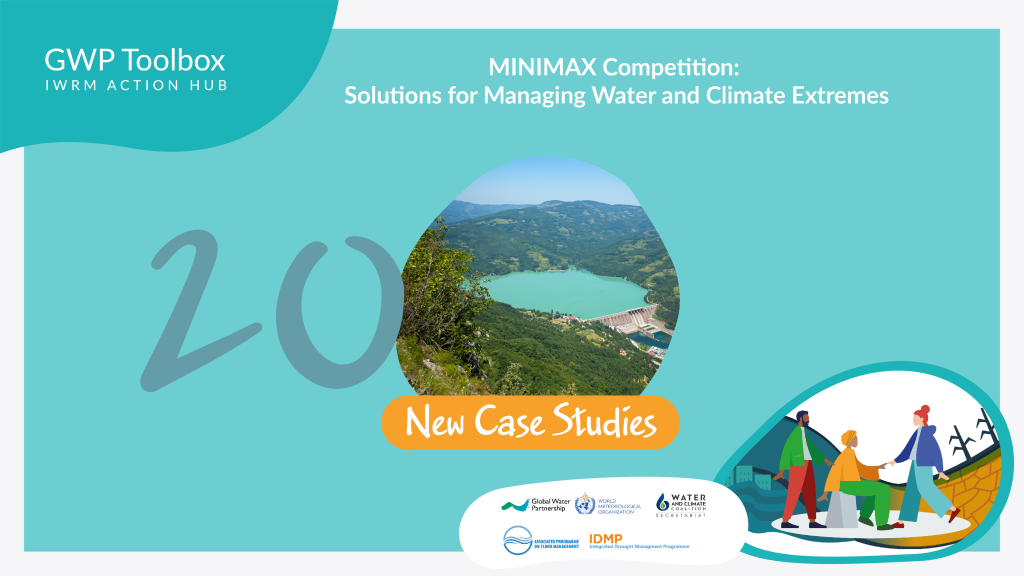In a time of hydroclimatic extremes, there is no single solution to minimise the negative impacts and maximise the positive. Instead there are many people, in many places, with many good ideas. As a follow-up to our MINIMAX Competition, therefore, we are proud to present the stories of 20 teams striving to tackle hydro-extremes and reap the benefits in innovative ways. This trove of solutions is browsable now on the GWP Toolbox.
The MINIMAX Competition was launched by GWP, the World Meteorological Organization (WMO), and the Water Climate Coalition (WCC) in March 2022 to collect and identify innovative water and climate solutions that could minimise the harm of hydroclimatic extremes and at the same time maximise social, economic, and environmental benefits. It has attracted numerous exciting solutions approaching the challenge at hand from new angles.
From among these, we have now published 20 stories across the four competition categories:
Developing climate smart water, sanitation, and hygiene (WASH)
Among the case studies focusing on the solutions for WASH sector, the winning project in Malawi managed to significantly improve disaster response by coordinating response efforts through real-time data management via the mWater platform. Another innovative solution from India offers an affordable solution to urban waterlogging in inundated slums by combining several rainwater harvesting technologies. Meanwhile, the case study from Korea shows how sanitation systems recycling sanitary waste in remote areas could be another way of increasing access to water and sanitation for disadvantaged communities. There are also great examples of engaging youth to design local water conservation solutions in the case study from Malaysia and of designing an innovative hybrid wastewater treatment device in the case study from young researchers in Senegal. Among the successful tools used in these cases have been IWRM Tools such as Nature-Based Solutions and Recycle and Reuse.
Winning MINIMAX Solution in this category:

Empowering and engaging youth meaningfully
Bringing youth engagement to solving water and climate crises, our winning project from Indonesia focuses on children by holding education and training in disaster mitigation with more engaging activities based on several learning styles through comics, songs, storytelling, and role-plays. Two other projects successfully employed alternative formats for community education, one in West Cameroon and another involving urban youth communities in Yaounde, Cameroon, training young water professionals on hydroclimatic risk assessment and raising awareness on water use habits. More concrete action has been taken by the initiatives coming from Tanzania and Nigeria, where in the former case young researchers engaged in collaborative mapping of early warning response using open-source technologies, and in the latter young geophysicists produced the first comprehensive recommendations for aquifer protection and groundwater resource management in a local area. Some of the IWRM Tools widely used for meaningful participation of youth included Multi-Stakeholder Partnerships and Youth Engagement and Empowerment.
Winning MINIMAX Solution in this category:

Enhancing water and climate finance
Diving into the initiatives aiming to enhance water and climate finance, a case study from Italy supports policy response with scientific data, providing innovative tools for flood damage assessment and informed decision-making. Another interesting approach to water finance was taken in a case study from Morocco where a water fund was created by a multi-stakeholder partnership to support investments on a basin level, using a financing mechanism based on payments for ecosystem services. A similar successful case of partnerships between national and international actors could be seen in Uganda, where integration of climate change adaptation into the catchment management plans for several basins was facilitated through accessing climate funding from the Adaptation Fund. The successes of mobilising funding through new partnerships are also prominent in the transboundary case from IGAD region. Here a regional early warning system is contributing to strengthening drought resilience in vulnerable communities by addressing the needs of each sector involved. Such IWRM Tools as Water and Climate Finance and the Vulnerability Assessment proved to be extremely useful.
Winning MINIMAX Solution in this category:

Leveraging water data and information
Building an efficient drought risk management system requires innovative tools, such as the early drought detection mechanism seen in the case from Danube river basin. Another successful example of digital tools used to support decision-making systems is a case from China where urban flood risks are managed in real time using a new flood modelling system which allows the authorities to select the most appropriate response scenario in advance. Diving deeper into the historical analysis of how humans manage water-related disasters, a case study from Giofyros river in Greece illustrates how to find the best flood resilient solution taking into account conflicts between human activities and hydraulic laws. Recognising the importance of socio-economic patterns among water users proved to be essential in a similar case in Central and Eastern Europe. Here the project team employs nature-based solutions to restore the natural water retention capacity of catchments and facilitates understanding of environmental data by stakeholders to prevent drastic impacts of floods and droughts. Using the IWRM Tools of Geographic Information System as well as Information Gathering and Sharing Networks helped these initiatives reach their goals.
Winning MINIMAX Solution in this category:

What’s Next?
Recognizing that any initiative thrives when supported by a vibrant community, we are planning to organise similar case study callouts with our thematic partners next year. The key objective here would be to highlight innovative solutions within a particular theme which have great potential to be scaled up in another region with similar natural conditions around the world.
Already this year we would like to involve the case study authors to participate in the Water and Climate Coalition Activity Marketplace which facilitates collaborative action on water and climate challenges. Through a series of matchmaking events organised by GWP, WMO and WCC we hope that our Minimax authors will find new initiatives and partners to take their solutions forward and scale up their approaches.

